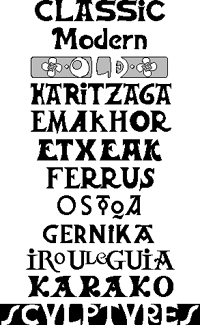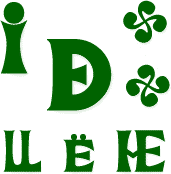10 October 2004
Type and Nation, 2
“Euskara - which means Basque in the Basque language - refers to all kinds of characters you can find in the Basque country. Indeed each of the seven French and Spanish Basque provinces has its own geographic and cultural characteristics. For instance, those who live on the seaside - itsasoan - differ from those who live in the mountain - itsasmendi. These differences can also be felt from one valley to the other.”
Modern Basque nationalism emerged at the end of the 19th century, marked by the formation of the Basque Nationalist Party in 1895. Part of the political and cultural program of the Party was a revival of a unified Basque language. And related to this was the celebration of a distinct Basque typography.
 In 1888, Louis Colas, a schoolteacher from Baiona, begin his travels across the Basque countryside on muleback on documenting ancient Basque monuments. Colas published his research in a large, heavy volume which cost him a fortune. It initially attracted few readers.
In 1888, Louis Colas, a schoolteacher from Baiona, begin his travels across the Basque countryside on muleback on documenting ancient Basque monuments. Colas published his research in a large, heavy volume which cost him a fortune. It initially attracted few readers.
The volume, though:
“is a genuine encyclopedia with more than 500 rough sketches and about 30 photos, tracing monuments and works since lost or destroyed. Unfortunately today, too few originals - some of them in a poor state - can be consulted as unquestioned references to the matter.” [source]
The Basques inherited their method of representing the sounds of language by literal symbols from the Romans.
“At that time, the Basque engravers knew very little about the Roman ironworks technique; their rough tools couldn’t carve deep characters like in the sculptures coming from Rome. So, instead of carving deeply, they scraped the stone around the characters which thus stuck out, creating a new technique. This explains why the Basque letters can hardly resist the passing of time: five-century-old engravings have been rubbed out, for the most part.
Moreover, very few people — such as old families of engravers — could write as well as engrave: such a treasure was to be kept secret. This explains the variety in the Basque characters. Not only did the children inherit the technique from their parents, but they also inherited the family mistakes: sometimes in a village, you may find the same misprints on the old houses fronts. The most powerful family in a valley also caught hold of all the written works. Still today, there are shapes in the carved stone which can be found only in some valleys; and it is the same for the ‘pelote Basque’, the rules of which varied according to the valleys which were the (mass) media of the time!” [source]
Later influence of the continental Celts was felt in particular on capital letters A, S, and N, and in the rare lowercase letters b, p, q, and o.
 Despite this influence and other printing fashions, the Roman influence predominates. There is hardly any Basque written work using cursive script. This results in part from the link between Latin and Christianity: almost all early written works in Basque were religious in content.
Despite this influence and other printing fashions, the Roman influence predominates. There is hardly any Basque written work using cursive script. This results in part from the link between Latin and Christianity: almost all early written works in Basque were religious in content.
The Basque nationalist movement was banned and forced underground in 1923 by the Spanish military dictatorship of Miquel Primo de Reviera, but flourished after proclamation of the Second Republic in 1931 and the lifting of the ban.
Despite military uprisings that divided the Basques, following a large scale campaign for Basque autonomy and a plebiscite in 1932, the Government of the Republic granted autonomy to the Guipuzcoa and Vizcaya regions. The first Aberri Eguna was held on Easter Sunday, March 25, 1932 celebrating the Basque homeland, culture and language, and Catholicism.
In the 1930’s printers and foundries lavished much attention on Mr. Colas’s book which encouraged Euskara’s revival.
“Euskara consists of large-footed, big-eyed, Roman-styled characters. (See Some Different Basque Letters). You should not use them for a whole text because it would give a sensation of thickness: they were used on mortuary epitaphs and fronts of houses, mostly. The general pattern is rather heavy but the ten existing lowercases makes it look lighter: it seems funny that hardly any lowercase can be found in Euskara, although typically Basque letters can be found (for example, the interpenetrated DE).”
Today Euskara can be found throughout the Basque country on signage, television, newspapers, and packaging.
“Among the various Euskara characters used in offset printing, the LetraSet transfer-types are very well spread, whereas only Spanish printers have still got lead characters. Neuhaus in Hendaye is a worth-mentioning firm: their local roadsigns, printed in Basque characters, help promote tourism. Lately, a young editor from Biarritz has tried to use the Basque culture characters [for computer printing].”
But given its current status as a kind of cultural brand for consumption by tourists and others external to the Basque community, does it still retain a nationalist connotation to the community itself? Or has it become depoliticized, commodified, and folkloric?

Thierry Arsaut designed the fonts displayed above.
Links to Basque fonts and more info.
![]() 10 October 2004, 8:40 PM | LINK | Filed in
nationalism, typography
10 October 2004, 8:40 PM | LINK | Filed in
nationalism, typography
Read more items related by tag:

